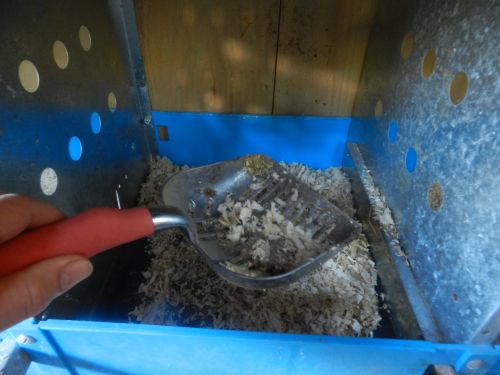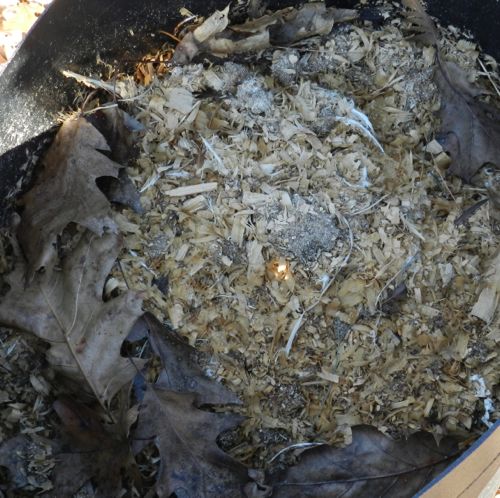Chickens poop. A lot. Each one of your hens will produce about a quarter pound of manure a day, which according to one source, is 1 cubic foot every six months (I haven’t measured it myself!) Birds don’t pee. Everything that they excrete comes out in one large plop. It’s big, bulky and smelly. It is also a potential carrier of disease and internal parasites, and is a medium that all sorts of unpleasant bugs, such as flies, want to live and breed in. Chicken manure is 75% water and is very high in nitrogen. As the nitrogen decomposes, it gives off ammonia gas. Using dry and absorbent bedding, and having a well-ventilated coop is the first piece of the management plan to keep your hens healthy and living in an environment that is a pleasure for you and the chickens to be in.
The next part of the plan is manure removal. I like using pine shavings as bedding because it dries out the manure and can be sifted through. Hay and straw is not absorbent and becomes wet and matted. I use shavings in the nesting boxes and on the floor. If a hen poops in the nesting box, it’s easy to clean out using a kitty litter scoop. I do this daily. I might also use the scoop if I see a big pile on the floor.
Once a week I go into the coop and, using a fine-tined pitchfork, sift through the shavings, removing the manure. You won’t get all of it, as some will already be dried and broken into tiny bits, but you’ll be able to get the bulk out.
Most of the manure will accumulate under the roosts. Some coops are designed to have “poop boards” where the manure lands, and is untrodden on by the hens. That manure should be scraped off of the boards daily.
Once the manure is removed, if necessary, I add some fresh bedding. Chickens shred everything into tiny bits and eventually both the shavings and manure will turn into fine dust. If you can feel this dust when you breathe, it’s an unhealthy environment for both you and the hens. The dust will coat everything in the barn and will harbor bacteria. So, every few months I shovel everything out and start fresh. By the way, it’s said that cedar shavings give off fumes that are bad for animals. Other woods are okay, although not widely available, but if you have a woodshop, you can use most other shavings. However, the pine is the most absorbent and safest for your birds.
Since my chickens are confined to dirt pens, those need to be cleaned, too. I use a flexible metal rake to gather what manure I can, and shovel it up. It’s important to keep the dirt in the run dry. Adding coarse builders sand (sold in bags at lumber yards) will improve drainage, and the hens love to dust bathe in it.
I keep a compost pile in the chicken run. I put kitchen scraps, weeds and leaves in it, but I don’t include the manure. Internal parasites, like roundworms and tapeworms, shed eggs and/or body parts in the chicken manure, that then require intermediary hosts to survive. These hosts are usually insects, like dark wing beetles, that live in damp, dark places near the chickens. By removing the manure front the pen, I’ve stopped the cyle. I’ve never had to worm my hens. I run fecal samples so know that I have never had a problem.
Chicken manure cannot be put directly onto your garden as it will “burn” your plants. Also, you don’t want to put it fresh onto vegetables as it might carry salmonella or e. Coli. However, although it starts out noxious, when composted, chicken poop ends up as dark loamy earth. There’s a lot of advice about how to take care of compost, which all seems complicated and time-consuming. I’m a lazy composter and I don’t want to turn piles of manure or pay attention to it. Also, I have dogs who would relish the chance to roll in chicken poop, so I need a method that keeps it out of the way. What I came up with is cheap and tidy. I use plastic garbage cans that have been thrown out because their bottoms cracked. I cut off the ends, and put the trash cans near my vegetable patch. I add the manure and the shavings, and also, once in awhile, dead leaves and discarded greens.
As the manure dries out and the mass shrinks, I add more material. Even in the winter, when the compost is frozen, I keep topping it off. Once it is full, I let it sit for at least six months. It will go from this:
To this:
This manure is very rich, and high in nitrogen and calcium. It’s terrific straight on my bare pumpkin patch that has anemic soil, and mixed into the dirt of my vegetable and flower beds. Nine years ago I started gardening on this property that was mostly granite gravel and poor soil. Now my flower beds look like this, thanks to the girls and their manure.







